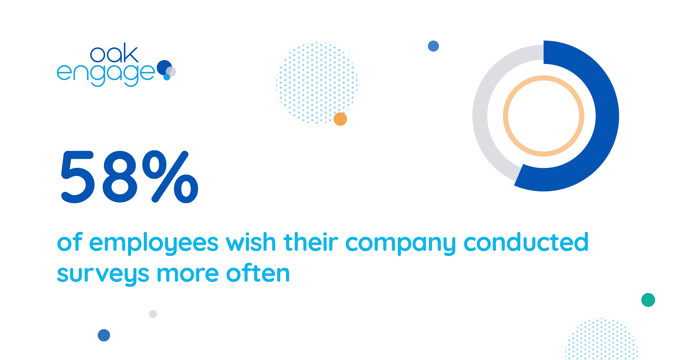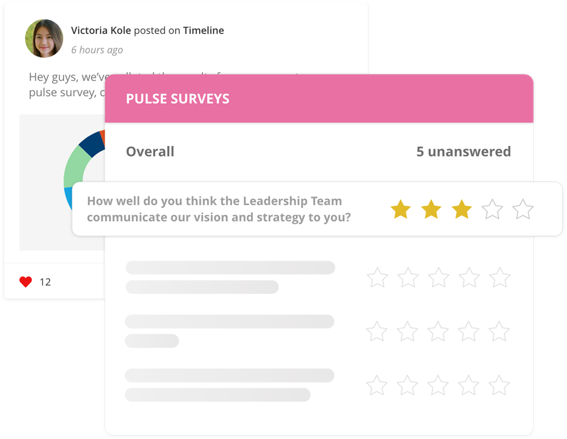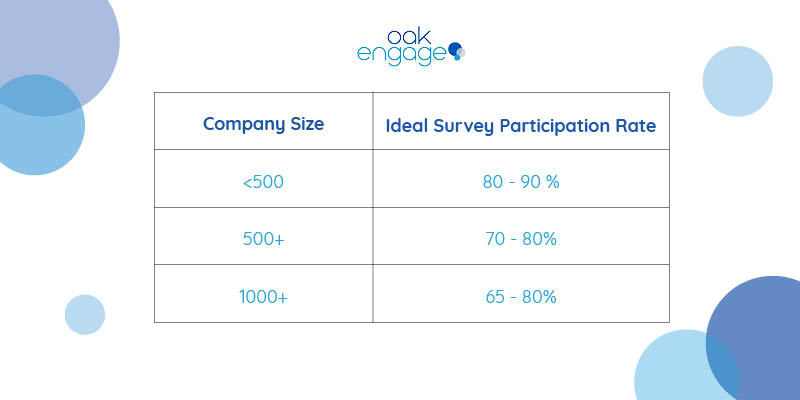Happy and engaged employees are a key asset to any business. But how can you be sure your employees are happy with their work and engaged within the organisation?
Pulse Surveys are an increasingly popular and reliable way of getting honest and actionable feedback from employees. In this blog post we’ll be providing with you the Ultimate Beginners Guide to Pulse Surveys.
- What is an Employee Pulse Survey?
- Pulse Survey vs Engagement Survey
- What is the purpose of a Pulse Survey?
- What can a Pulse Survey measure?
- How do you create a Pulse Survey?
- Pulse Survey best practices
- What questions should be included in a Pulse Survey?
- What is a good Pulse Survey response rate?
- How to Increase Employee Survey Participation rates
- How Pulse Surveys Improve Employee Engagement
What is an Employee Pulse Survey?
Pulse surveys are a brilliant tool for gathering useful feedback from your employees. They’re a great way to understand how people in your organisation really think and feel about certain subjects. With quality data behind you, you can always be confident in making the right changes.
Sent out on a consistent basis - either monthly, quarterly or even weekly - Pulse Surveys act as a check in and can range on topics from employee satisfaction, communication, the work environment and more.
The results from pulse surveys are measurable and provide you with data so you can analyse which areas of the business need improvements to take action.
Pulse Survey vs Engagement Survey
“But aren’t pulse surveys and engagement surveys the same thing?” Not quite...
Pulse surveys are shorter and more frequent, they’re a chance to see how your entire workforce feels regularly whereas engagement surveys happen once, maybe even twice a year. Let's take a look at the differences…
Pulse surveys are:
- Shorter than engagement surveys
- Quick to complete
- Anywhere from 5 - 30 questions, depending on the frequency they’re sent out
- Conducted on a more regular basis and help gain quicker, relevant feedback
- Normally focus on a specific issue or question
Engagement Surveys:
- They’re sent out annually or bi-annually, providing a yearly snapshot of your workplace
- Consist of more questions
- Cover a wide range of topics
- Take longer to complete
There’s no denying that engagement surveys are useful, however research does show that employees want the opportunity to provide feedback and have their voices heard more frequently, not just once per year.
The two tools can work in tandem together. Pulse surveys aren’t meant to take the place of engagement surveys, rather they’re meant to be complementary and work hand in hand to support continuous feedback and improvements for your organisation. It’s much easier to take actionable steps when you’re receiving feedback more often.
What is the purpose of a pulse survey?
It’s important to create an environment where employees feel valued and heard. The potential frequency in which you can distribute pulse surveys allow you to do just that. They’re perfect for noticing patterns and trends over time. There are various benefits of using pulse surveys:
Employees want more frequent surveys
Employees are 12 times more likely to recommend your organisation as a great place to work if their feedback is being listened to and actioned and 58% of people wish their company conducted surveys more frequently. Make sure your employees feel like their opinions matter.
Pulse surveys drive engagement
By using pulse surveys as a tool within your business to gain feedback, you’re showing that you're invested in hearing what your employees have to say and care about their opinions which will increase employee loyalty, commitment and advocacy - all essential components that make up employee engagement.
You’ll get open, honest feedback
Whilst 1:1s and discussions might be the preferred method of communication for some, 77% of employees stated that they would be more honest in a survey than in a conversation with a manager. It can be hard to talk candidly to someone personally, and employees will most likely feel more comfortable answering questions on a survey and you can resolve any issues mentioned with ease.

What can a pulse survey measure?
A pulse survey can measure just about anything! But the questions you’re asking should be relevant to your organization's goals and priorities and they should track the same item over time. A few subjects you could potentially measure are;
- Employee satisfaction
- Employees health and wellbeing
- Employees opinions of the organisation
- Feedback on company initiatives
- Trust
- Employee engagement levels
- Personal growth
- Attitudes to remote working
How do you create a pulse survey?
To create a pulse survey, you’ll need to use a survey tool. There are various different options available with specific benefits, here’s a few to get you started:
- SurveyMonkey
- Google Forms
- TypeForm
- SoGoSurvey
- Survey Gizmo
- Survey Planet
Once you’ve created your pulse survey you can distribute this easily via an Intranet so that everyone in your company can access and complete them.
Some Intranets allow you to create Pulse Surveys as a feature, with Oak Pulse Surveys you have everything you need and can utilise tools to collate insightful data from employees, all from within your intranet.

Pulse Survey Best Practices
It’s important to make sure you’re getting the right data from your pulse surveys so that you can take meaningful action. Following best practices means you’ll create an effective pulse survey that people are engaged with so you can get the right information from your employees:
Have a clear goal in regards to what you’re measuring
Are you investigating HR issues like high turnover or trying to get a general sense of employee satisfaction? Goals of the survey will inform the questions you ask. Be sure to articulate a clear goal before you start to build a survey.
Take time formulating your questions
The data you collect from pulse surveys must be correct so that you can take action with the answers. Make sure questions are clear and result in valuable answers that can inform any potential changes you might need to make. Having clear goals should help you determine specific and clear questions.
Promote pulse surveys to your workforce
Many organizations have low participation rates as they fail to promote their pulse surveys. Employees then forget to fill out surveys or are less inclined to complete them. Make sure you explain why responding to the survey is important and how their feedback will allow you to continually work on making the workplace better for them. Cultivate a greater culture where employees are given a voice and heard. Remind them that they’re 100% anonymous.
Share results and announce the next steps
Employees are likely to be curious about the survey results. It’s reassuring to know that other employees are experiencing the same pain points as them. Make sure HR shares the most important survey findings. This shows transparency so everyone will be informed about what's happening in the organisation and can follow along with issues that are being prioritized.
Follow through with actions
Taking action from the findings creates a positive feedback loop and employees will value companies who actually make valuable changes with their feedback. It’ll also encourage them to participate in future surveys and the results will be more honest and accurate.
What questions should be included in a pulse survey?
A general rule of thumb is the more frequent the pulse survey, the shorter it should be in length. So if you're sending your pulse surveys out monthly it should consist of 10-15 questions. If it’s quarterly, 15-20 questions is a good number and bi-annually should contain between 20-30 questions. But what should you include in yours?
It’s important to note that it’s a good idea to have a mixture of questions.
The majority of questions should be sliding/rating scale questions and multiple choice to get numeric data you can get accurate results from. This helps make results measurable. You can take action from this but it’s also important to have open-text questions to give your employees the chance to speak in their own words, open-text questions give people the opportunity to explain their responses and give you deeper insight.
Here are some question ideas for particular topics to spark some inspiration:
Employee Satisfaction Questions
- How happy are you at work?
- If you could, what's the one thing that you would change about your job?
- On a scale of 1-10 how would you rate your work life balance?
- Are you satisfied with the perks that you’re receiving?
Employees Opinions of the Company
- My personal values align with company’s vision and mission
- How likely are you to recommend your organisation to someone you know?
- I trust our senior leaders to lead the organisation to future success
- I believe this organisation will be successful in the future
Feedback on Company Initiatives
- I noticed positive changes as a result of the last survey
- My manager shared the results of the last survey with our team
- Our organisation has done a good informing employees about [initiative]
- We have effectively managed the recent change in our organisation
Employee Engagement
- I receive meaningful recognition for doing good work
- I feel comfortable giving opinions and feedback to managers
- I see myself still working at [Company Name] in two years time
- [Company Name] motivates me to go beyond what I would in a similar role elsewhere
Personal Growth
- I have access to everything I need to perform to the best of my ability
- I am given opportunities to learn and develop my skills
- I can see clear progression in my role
- I know what constitutes good performance in my role
Remote Working
- I feel supported by my manager when working from home
- I feel connected to my team when working from home
- I felt informed about the organisation's goals and priorities when working from home
- Our remote work tools are suitable and allow me to complete my work effectively
What is a good pulse survey response rate?
Employee engagement surveys usually only get a 30-40% response rate. Pulse surveys on the other hand are widely used with a response rate of around 85%. There are a number of factors that can impact your response rate but depending on the size of the company, there are ideal survey participation rates.

How to increase employee survey participation rates?
How can you make sure that your employees are actually completing pulse surveys and are engaged so you can make actionable changes?
- Pre-survey Communication: it’s important to make announcements to employees beforehand to ensure that employees are aware and recognise the importance of participation and what it means for them. Brief them about the importance of receiving their feedback and how you would like them to support it and the benefits it will bring.
- Share the results quickly: share the results as soon as possible after the survey closes. Create infographics so that everyone can view the findings in a visually appealing and easy to interpret way and inform employees of how the results are going to impact particular changes.
- Demonstrate an intent to make practical changes: pulse surveys are an incredibly powerful tool, but only if you use the data to make changes. If employees know that what they say could result in positive action, they’re going to be more likely to engage with pulse surveys.
How pulse surveys improve employee engagement
Companies with engaged employees outperform companies without engaged employees by 202% and 77% of employees want to provide feedback more than once a year. They want to know that their opinions are valued. So how do pulse surveys directly impact employee engagement?
Pulse Surveys foster a positive communication culture
Regularly asking staff for their opinions and feedback through pulse surveys encourages positive engagement and creates a two way conversation. The chance to share opinions lets employees know that you value their views and are willing to make changes based on their thoughts and feelings. Employees will be satisfied knowing that their opinion is valued and as a result become more invested in the success of the organisation, becoming more productive and highly motivated.
You’ll receive relevant feedback
By conducting pulse surveys, you’ll gain meaningful insights into subject areas you know need to be improved, altered or changed and be able to track this frequently. Creating a two way narrative means you collaborate with employees and put their voice first to make your workplace better rather than implementing changes that have no relevance to your workforce.
They’re quick to complete and have high response rates
No matter where your employees are, they’ll be able to complete a pulse survey. With pulse surveys being short and frequent, they’re easier to complete which results in a higher participation rate. Frequent feedback means it will be easier to build a strong company culture and levels of trust from employees will increase.
Creating a positive workplace culture and making sure your employees are happy starts with feedback. Regularly asking your employees their views and assessing their needs and wants is vital to creating an environment where they are happy and thriving and pulse surveys are the perfect tool to do so.
Want to see how you can use Oak to create and distribute Pulse Surveys?




